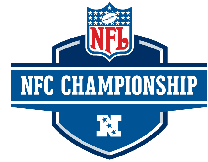
Here’s a look at the always-convoluted NFL Playoff picture.
 In the AFC the New England Patriots have clinched AFC East, the top seed and home field advantage. They will have a first round bye along with the Indianapolis Colts who have clinched the AFC South and #2 seed in the conference.
In the AFC the New England Patriots have clinched AFC East, the top seed and home field advantage. They will have a first round bye along with the Indianapolis Colts who have clinched the AFC South and #2 seed in the conference.
The San Diego Chargers have clinched the AFC West, the Pittsburgh Steelers can clinch the AFC North with a loss by the Cleveland Browns to Cincinnati today. The Steelers will be in the playoffs if Tennessee loses or ties.
The Cleveland Browns can clinch a playoff berth with win or Tennessee Titans loss or Cleveland tie and Tennessee tie. The Jacksonville Jaguars can clinch a playoff berth with win or tie or Tennessee Titans loss or tie or Cleveland Browns loss.
Tennessee needs a bunch of help that right now is so far fetched it’s not worth getting into.
Everyone else in the conference has been eliminated.
 In the NFC Dallas has clinched the NFC East and a first round bye and can clinch home field advantage with a Green Bay loss to Chicago. The Packers have clinched the NFC North and a first round bye.
In the NFC Dallas has clinched the NFC East and a first round bye and can clinch home field advantage with a Green Bay loss to Chicago. The Packers have clinched the NFC North and a first round bye.
The Seattle Seahawks have won the NFC West and the Tampa Bay Buccaneers have clinched the NFC South.
The New York Giants can clinch a playoff berth with a win or tie or Washington Redskins loss or tie or New Orleans Saints loss or tie. The Minnesota Vikings can clinch a playoff berth with a win and a New Orleans Saints loss or a tie.
Washington and New Orleans are still alive but need some help, much like Tennessee in the AFC.
Everyone else in the conference has been eliminated.
According to the 2007 NFL Record & Fact Book here are the tie breaker formula’s:
Ties count as one half win and one half loss.
TO BREAK A TIE WITHIN A DIVISION
If, at the end of the regular season, two or more clubs in the same division finish with the best won-lost-tied percentage, the following steps will be taken until a champion is determined:
Two clubs
1. Head-to-head (best won-lost-tied percentage in games between the clubs).
2. Best won-lost-tied percentage in games played within the division.
3. Best won-lost-tied percentage in common games.
4. Best won-lost-tied percentage in games played within the conference.
5. Strength of victory.
6. Strength of schedule.
7. Best combined ranking among conference teams in points scored and points allowed.
8. Best combined ranking among all teams in points scored and points allowed.
9. Best net points in common games.
10. Best net points in all games.
11. Best net touchdowns in all games.
12. Coin toss.
Three of more clubs
(Note: If two clubs remain tied after a third club is eliminated during any step, tiebreaker reverts to Step 1 of the two-club format.)1. Head-to-head (best won-lost-tied percentage in games among the clubs).
2. Best won-lost-tied percentage in games played within the division.
3. Best won-lost-tied percentage in common games.
4. Best won-lost-tied percentage in games played within the conference.
5. Strength of victory.
6. Strength of schedule.
7. Best combined ranking among conference teams in points scored and points allowed.
8. Best combined ranking among all teams in points scored and points allowed.
9. Best net points in common games.
10. Best net points in all games.
11. Best net touchdowns in all games.
12. Coin toss.
TO BREAK A TIE FOR THE WILD-CARD TEAM
If it is necessary to break ties to determine the two wild-card clubs from each conference, the following steps will be taken:A. If all the tied clubs are from the same division, apply division tiebreaker.
B. If the tied clubs are from different divisions, apply the following steps:
Two clubs
1. Head-to-head, if applicable.
2. Best won-lost-tied percentage in the games played within the conference.
3. Best won-lost-tied percentage in common games, minimum of four.
4. Strength of victory.
5. Strength of schedule.
6. Best combined ranking among conference teams in points scored and points allowed.
7. Best combined ranking among all teams in points scored and points allowed.
8. Best net points in conference games.
9. Best net points in all games.
10. Best net touchdowns in all games.
11. Coin toss.
Three of more clubs
1. Apply division tiebreaker to eliminate all but highest-ranked club in each division prior to proceeding to Step 2. The original seeding within a division upon application of the division tiebreaker remains the same for all subsequent applications of the procedure that are necessary to identify the wild-card participants.
2. Head-to-head sweep (apply only if one club has defeated each of the others or one club has lost to each of the others).
3. Best won-lost-tied percentage in games played within the conference.
4. Best won-lost-tied percentage in common games, minimum of four.
5. Strength of victory.
6. Strength of schedule.
7. Best combined ranking among conference teams in points scored and points allowed.
8. Best combined ranking among all teams in points scored and points allowed.
9. Best net points in conference games.
10. Best net points in all games.
11. Best net touchdowns in all games.
12. Coin toss.
When the first wild-card team has been identified, the procedure is repeated to name the second wild card (i.e., eliminate all but the highest-ranked club in each division prior to proceeding to Step 2.) In situations where three teams from the same division are involved in the procedure, the original seeding of the teams remains the same for subsequent applications of the tiebreaker if the top-ranked team in that division qualifies for a wild-card berth.
OTHER TIE-BREAKING PROCEDURES
1. Only one club advances to the playoffs in any tiebreaking step. Remaining tied clubs revert to the first step of the applicable division or wild-card tiebreakers. As an example, if two clubs remain tied in any tiebreaker step after all other clubs have been eliminated, the procedure reverts to Step 1 of the two-club format to determine the winner. When one club wins the tiebreaker, all other clubs revert to Step 1 of the applicable two-club or three-club format.
2. In comparing records against common opponents among tied teams, the best won-lost-tied percentage is the deciding factor since teams may have played a n unequal number of games.
3. To determine home-field priority among division champions, apply wild-card tiebreakers.
4. To determine home-field priority for wild-card qualifiers, apply division tiebreakers (if teams are from the same division) or wild-card tiebreakers (if teams are from different divisions).
TIEBREAKING PROCEDURE FOR SELECTION MEETING
If two or more clubs are tied in the selection order, the strength-of-schedule tiebreaker is applied, subject to the following exceptions for playoff clubs:
1. The Super Bowl winner is last and the Super Bowl loser next-to-last.
2. Any non-Super Bowl playoff club involved in a tie shall be assigned priority within its segment below that of non-playoff clubs and in the order that the playoff club exited from the playoffs. Thus, within a tied segment a playoff club that loses in the wild-card game will have priority over a playoff club that loses in the divisional playoff game, which in turn will have priority over a club that loses in the conference championship game. If two tied clubs exited the playoffs in the same round, the tie is broken by strength of schedule.
If any ties cannot be broken by strength of schedule, the divisional or conference tiebreakers, whichever are applicable, are applied. Any ties that still exist are broken by a coin flip.